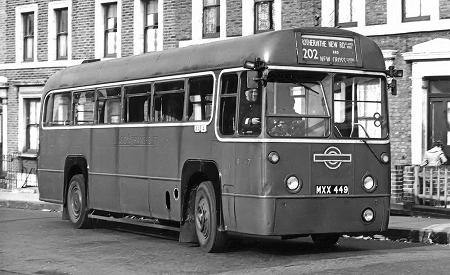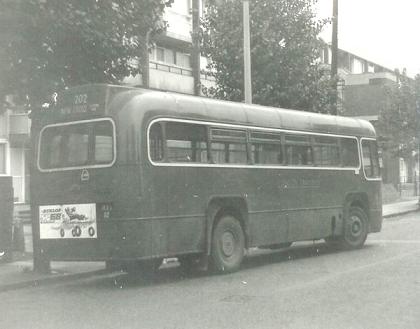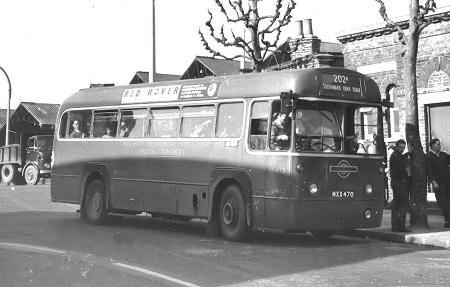|
|
 Red RF routes Red RF routes
Route 202 and 202A
Page last updated 9 April
2015
This page is dedicated to the
memory of 202 conductor Alan Neale (1936-2012), who
enjoyed recreating the
route in 2010.
The inner-most single-deck route in London until the Red
Arrows of 1966, the 202 served the then-busy industrial area of
South Bermondsey. A series of route
changes included (variously and confusingly) conversion to a
circular route and temporarily splitting into 202 and
202A. The first route to lose RFs in favour of
Merlins.
RF472 seen in Pagnell
Street, New Cross on the terminal loop, 20 March 1960.
Dates of RF operation
17 Dec 52 to 25 Oct 68
(total 15 years 11 months, all crew
operation).
Route 202A: 1 Jul 64 to 10 Mar
67
Destinations
NEW CROSS Clifton Rise to ROTHERHITHE NEW
ROAD Canal Bridge (daily 13 Dec 52 to 10 Dec 57,
daily 1 Jul 64 to 10 Mar 67, plus Sundays during operation of
circular route)
NEW CROSS Clifton Rise and ROTHERHITHE NEW ROAD
St James's Road (circular) (Mon-Sat: 11 Dec
57 to 30 Jun 64, 11 Mar 67 to 25 Oct 68)
Route 202A: NEW
CROSS Clifton Rise to SOUTHWARK PARK ROAD (Mon-Fri peaks
and midday, 1 Jul 64 to 10 Mar 67)
 RF Garages RF Garages
P Old Kent Road (until closure on 25
Nov 58)
NX New Cross (from 26 Nov 58)
Route 202 last night of operation, 25 October
1968 - RF 370 displays the informative display (for a circular
route) New Cross Clifton Rise (here it is running
away from New Cross) and stands at the first stop in
Hawkstone Road just after Surrey Docks station. This road has
not been used by buses since Canada Water station opened and
the local routes were altered to run into the bus station.
RF370 moved on the the 236, but is
today in rather a poor state (photos
© Paul Redmond, Peter Osborn). Main photo ©
Chris Stanley
Reason for single-deck operation
The route was always single-deck operated because of low
bridges in Trundleys Road, including one carrying
the Bricklayers Arms goods yard line which descended at a
shallow gradient for the very heavy goods trains. Some
of the low bridges are still there and bus routes along the road
are still single-decked.
Route history
Introduced as the 202 by independent companies GH Allitt &
Sons Ltd (with Dennis Es) and Robert Hawkins & Co. Ltd ('Nil
Desperandum', Leyland Lions, pictures here and here)
on 23 Jul 29, the route initially ran only from New Cross to
Rotherhithe Red Lion, but was extended to Canal Bridge at
the end of the year. The two operators were joined in
1931 by Renown Traction Co. Ltd (for 4 months, until their
only single-decker caught fire) and E Puttergill ('Golden
Arrow', also with a Dennis E). Between November 1933 and June
1934, the three remaining operations were acquired by the LPTB,
although GH Allitt continued as furniture removers in Rotherhithe
New Road until at least the 1960s. Workings started from Old
Kent Road garage (P) in January 1934, with a mixture of
DE-class Dennises and LN-class Leylands.
The Renown workings, as described by Ken Glazier, are of
interest in providing a sidelight on the restrictions faced by
independent operators before the amalgamation that formed the
LPTB. Renown operated from a base in East Ham, with garage
runs via Barking Road and Rotherhithe Tunnel operated in service
(so-called 'when working' journeys). Barking Road proved to
be more lucrative than the 202 itself, but additional schedules on
that road could not be obtained, so Renown designed schedules with
an abundance of 'when working' journeys, covering nearly as much
mileage as operated on the 202 proper.
Old Kent Road's Q152 on
the stand in Achilles Street, New Cross, in about 1951.
This is one of the batch that was originally green.
Photo © MG Webber,
Paul Brophy collection
It was in 1934 that the Rotherhithe New Road terminus
became known as 'Canal Bridge', whilst Clifton Rise was known as
Clifton Hill until 1937. In May 1936, the ex-independent
buses were replaced by nine crew-operated side-engined 5Q5s,
running every 5 minutes. The route was
always single-deck operated because of low bridges in
Trundleys Road, including one carrying the Bricklayers Arms
goods yard line which descended at a shallow gradient for the
very heavy goods trains. However, it was a very busy
route, so whilst the Qs gave 15 years' good service, the
route was an early priority for conversion to the new RFs in
1952, providing an extra 4 seats on each bus.
Although nominally converted on 13 Dec 52, conversion was staged
over the period 17 to 24 December as the new RFs were
licensed. Seven RFs replaced seven 5Q5s and one 10T10 on the
route, which required seven buses on weekdays.
A spare bus was again provided from 1 Jan 53, in the form of
another 10T10, replaced in turn by post-war T768 in April that
year.
The Canal Bridge terminal working was changed for the RFs, to
turn using Verney Road - previously the Qs did a loop in the road
at the St James's Road junction - but it wasn't until June
1954 that the stand moved from Rotherhithe New Road into Verney
Road.
Once the market in Southwark Park Road was less busy, from 11
Dec 57, the route was changed for weekday working only to become a
circular serving St James's Road and Southwark Park Road.
Unusually so late on, the same route number was used for the two
different routes, with the Sunday service staying
unchanged. The circular route operated both ways from
and to New Cross.
Despite carrying a blind
for the clockwise circular service from and to New Cross, RF432 is
laying over at the Old Kent Road Canal Bridge stand in Verney Road,
Rotherhithe, in this view. Perhaps this is a Sunday.
Old Kent Road garage, which was very
close to Canal Bridge, closed after 25 Nov 58 and New Cross took
over the route. Rather than operate garage journeys at the
other end of the route, however, they were operated from Canal
Bridge along Old Kent Road and the schedules remained
unchanged.
A weight restriction on the railway bridge in St. James'
Road led to the severance of the circle and the consequent
introduction of the 202A on 1 Jul 64. The 202
reverted to its original working and the 202A
diverged from the 202 to turn up Galleywall Road with route 1
and terminated at the far end in Southwark Park Road. It
worked in the peaks and lunchtimes, to serve Peek Freans and
Shuttleworths chocolate factory. The stand was soon moved
from Ambrose Street to Anchor Street.
In less than three years, from 11 Mar 67, the railway
bridge in St. James' Road was rebuilt, the 202A was
withdrawn and the 202 reverted to its circular route on
weekdays.
Such a short route was an obvious candidate for the new ideas
of flat-fare one man operation, and on 26 Oct 68, a month after the
Bus Reshaping Plan commenced, the
202 became the first red RF route to be replaced by flat-fare
Merlins. The replacement ran as the P1
(anticlockwise, following the 202, Mon to Sat and as per the
202 Sun) and P2 (clockwise, but from Surrey Docks taking the
Rotherhithe loop to Rotherhithe Station in part replacement for the
82, rather than going to New Cross). The leaflet and flyer issued by LT describe the
extent of the changes.
The first day of the new
regime, 26 Oct 68. MBS255 on the P1 loads at the Bonamy
Estate (now demolished) in Rotherhithe New Road, just north of
Verney Way.
Photo © Chris
Stanley
It was hardly surprising that the conversion was a
disaster. With fewer buses (every 7 minutes instead of every
5 minutes in the morning peak), fewer seats (but plenty of standing
room), no conductor and no change given, the position
would have been bad enough. But the notorious unreliability
of the Merlins made matters worse. A mechanic who worked at
NX in the early 70s (when the Merlins were replaced by smaller
Swifts) reports that sometimes there was only one SMS available out
of a requirement of 7 to operate both routes, so it alternated
between the P1 and P2 which left over an hour between buses.
RF route in detail, with timing points
Canal Bridge service:
NEW CROSS Clifton Rise, Clifton Rise, Woodpecker
Road, Trundleys Road, Bush Road, Rotherhithe New Road, Rotherhithe
Old Road, Surrey Docks
Station, Hawkstone Road, Rotherhithe New Road, Verney Road,
ROTHERHITHE Canal Bridge
Circular route:
NEW CROSS Clifton Rise, Clifton Rise, Woodpecker
Road, Trundleys Road, Bush Road, Rotherhithe New Road, Rotherhithe
Old Road, Surrey Docks
Station, Hawkstone Road, Rotherhithe New Road, Galleywall
Road, Southwark Park Road, St
James’s Road, Rotherhithe New Road, Hawkstone Road, Surrey Docks Station, Rotherhithe Old
Road, Rotherhithe New Road, Bush Road, Trundleys Road, Woodpecker
Road, Clifton Rise, NEW CROSS Clifton Rise
Operated in both directions.
202 A:
NEW CROSS Clifton Rise, Clifton Rise, Woodpecker
Road, Trundleys Road, Bush Road, Rotherhithe New Road, Rotherhithe
Old Road, Surrey Docks
Station, Hawkstone Road, Rotherhithe New Road, Galleywall
Road, SOUTHWARK PARK ROAD St James’s Road
On the introduction of a one-way system at Surrey Docks
Station in about 1966, the route(s) were amended in the New Cross
direction to run from Rotherhithe New Road via Rotherhithe Old
Road, Lower Road, Bestwood Street to Trundleys Road.
Terminal working at New Cross: From Clifton Rise, Walpole
Road, Pagnell Street, Achilles Street (stand at the Clifton Rise
end). Exit direct to Clifton Rise.
Terminal working at Canal Bridge: Rotherhithe New Road, Verney
Road (spur from north), Verney Road (stand at the south-east end,
from 1954). Exit direct to Rotherhithe New Road.
Terminal working of 202A at Southwark Park Road:
Ambrose Street to stand, changed within four weeks to Anchor
Street. Exit believed to be via Rosebery Street.
Maps © London Transport
Frequency
| Year |
Mon-Fri |
Sat |
Sun |
| 1936 |
5 mins |
5 mins |
7 mins |
| 1941 |
5-7½ mins |
4-5 mins
|
6-7½ mins |
| 1946 |
4-7½ mins |
4-7½ mins |
10-12 mins |
| 1951 |
5-7½ mins |
5-7½ mins |
7½-10 mins |
| 1959 |
10-18 mins* |
12-18 mins* |
10-12 mins |
| 1964 |
5-9 mins† |
7-12 mins |
20 mins |
* each way round the loop
† plus 202A, every 10 mins (peaks) and 3 lunch-time
journeys
The route took about 13 minutes from New Cross to Rotherhithe
New Road and 31 minutes for the loop working. The November
1959 timetable, showing the differing weekday and Sunday
workings, is here (thanks to Roger
Newport for scanning these). The July 1967 timetable is
here.
Faretable
To view the faretable for May 1965, during the operation of
the 202 A and including New Cross garage journeys,
click here.
 In this atmospheric view from 1965, the
202 A is clearly very well used - the service
ran every 10 minutes in the peaks. RF 473 is outside the old
Surrey Docks station in Rotherhithe Old Road, going towards New
Cross - not Southwark Park Road, the blind has not been changed for
the return journey. The bus has just turned out of Hawkstone
Road. See Paul Brophy's notes below. Photo © Colin Stannard, with apologies for
poor quality reproduction
Vehicle allocation
New RFs delivered Dec 1952 to P: RF 378, 380, 382, 384-5, 387
+ 1 ex-AV (367) (total 7, no spares)
PVR 1952 (Dec): Mon-Fri 7, Sat 7, Sun 5
PVR 1955 (May): Mon-Fri 6, Sat 6, Sun 5
PVR 1955 (Oct): Mon-Fri 7, Sat 6, Sun 5
PVR 1957 (Oct): Mon-Fri 7, Sat 6, Sun 4
PVR 1960 (Oct): Mon-Fri 7, Sat 6, Sun 2
PVR 1962 (Oct): Mon-Fri 7, Sat 5, Sun 2
PVR 1964 (Jul, joint 202/202A): Mon-Fri 7,
Sat 5, Sun 2
PVR 1966 (Dec, joint 202/202A):
Mon-Fri 7, Sat 4, Sun 2
PVR 1967 (Mar): Mon-Fri 7, Sat 4, Sun 2
Memories
Alan Neale was
a conductor at Old Kent Road garage (P), then Camberwell
(Q), between 1956 and 1962. His memories of his
time with London Transport are here.
Paul
Brophy remembers the area well:
'Up until the mid 1960's, buses used Hawkstone Road both ways
on routes 1 and 202, then a one way system was introduced to the
area and although Hawkstone Road was still two way for traffic,
buses only used it towards London. Once Canada Water station opened
all the bus routes in the area were altered to serve it and buses
were withdrawn from the road altogether. The stop in Hawkstone Road
where RF370 is standing [rear view above] was very busy in the mid
1970's onwards. The reason was that if you wanted to get a bus
towards Central London, you had a choice of route 1 from Hawkstone
Road (with buses either coming up from Bromley/Catford or from the
Surrey Docks Station stand in Rotherhithe Old Road), route 188 at
the stop shown (coming from Greenwich or the stand at Surrey Docks
Station), or the 70 from the 188 bus stop. The 188 met the 1 at the
Bricklayers Arms and ran parallel with it to the Aldwych, the 70
meet them at Waterloo. So at a Mon-Fri morning peak, there was a
big group of passengers all on the corner of Rotherhithe Old Road
and Hawkstone Road looking out for buses and then making a quick
dash to ether the bus stop in Rotherhithe Old Road or the one in
Hawkstone Road, all trying to get on a very full bus with a load of
its passengers trying to get off to join the East London line tube.
I think the bus crews hated those two stops.'
Re-creation
In 2010, RF486 ran over the old 202 route with
some former Old Kent Road staff, including Alan Neale. A
photo-report is here.
|
|